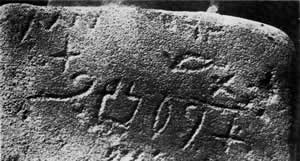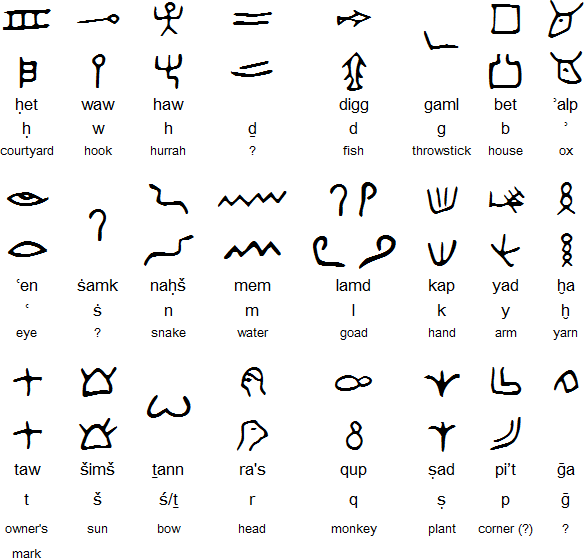Протосинайската писменост е първата азбучна система за писане и се развива някъде между 1900 и 1700 г. пр.н.е. Хората, говорещи семитски език и живеещи в Египет и Синай, адаптираха египетските йероглифни или йератични писмености, за да напишат своя език, използвайки акрофоничния принцип. Това включваше избор на около 30 глифа, превод на техните египетски имена на семитски език и използване на началните звуци на тези имена, за да представят звуците на техния език.
Например египетското nt (вода) става mem на семитски и представлява звука /m/ и в крайна сметка се развива в латинската буква M.
Надписи на протосинайски са открити в Серабит ел-Хадим (سرابيت الخادم) планина в Синай и в храм на египетската богиня Хатор (ḥwt-ḥr), който се намира там. Сценарият е частично дешифриран от Алън Гардинър през 1916 г. Надписи, много подобни на тези, открити в Серабит ел-Хадим, са открити в Уади ел-Хол (وادي الهول).
Прото-ханаански е име, използвано за версия на прото-синайското писмо, използвано в Ханаан, област, обхващаща съвременния Ливан, Израел, Палестина и западните части на Сирия. Използва се и за обозначаване на ранна версия на финикийската писменост, използвана преди 1050 г. пр.н.е., или предшественик на финикийската писменост.
Малък брой протоханаански надписи, датирани от 17 век пр.н.е., са открити в Ханаан. Повечето са кратки и вероятно са написани от говорещи семитски пътници или войници от Египет.
Протосинайската писменост е писмена система известна от ограничен брой източници в от средната бронзова епоха в Синай и Египет. Фрагментарните източници не дават голяма информация за характера на писмеността, но се предполага, че това може да е абджад, предшестващ финикийската писменост.
Протосинайската писменост е известна от два основни източника – надписи, открити през зимата на 1904 – 1905 година в Синай от Хилда и Флиндърс Петри и датирани в периода между 1700 – 1400 г. пр.н.е., и друга група надписи, открити през 1999 година от Джон и Дебора Дарнел в Среден Египет и датирани към XVIII век пр.н.е. В Синай има мини, експлоатирини по времето на Древен Египет, в които работят много „азиатци“, говорещи ханаански езици. Предполага се, че писмеността възниква при управлението на фараона Аменемхет III.
The Proto-Sinaitic script was the first alphabetic writing system and developed sometime between about 1900 and 1700 BC. People speaking a Semitic language and living in Egypt and Sinai adapted the Egyptian hieroglyphic or hieratic scripts to write their language using the acrophonic principle. This invovled choosing about 30 glyphs, translating their Egyptian names into the Semitic language, and using the initial sounds of those names to represent the sounds of their language.
For example, the Egyptian nt (water) became mem in Semitic and represents the sound /m/, and eventually developed into the Latin letter M.
Inscriptions in Proto-Sinaitic have been found at Serabit el-Khadim (سرابيت الخادم) a mountain in Sinai and at a temple for the Egyptian goddess Hathor (ḥwt-ḥr) that is located there. The script was partially deciphered by Alan Gardiner in 1916. Inscriptions very similar to those found at Serabit el-Khadim have been found at Wadi el-Hol (وادي الهول).
Proto-Canaanite is a name used for a version of the Proto-Sinaitic script as used in Canaan, an area encompassing modern Lebannon, Israel, Palestine and western parts of Syria. It is also used to refer to an early version of the Phoenican script as used before 1050 BC, or an ancestor of the Phoenician script.
A small number of Proto-Canaanite inscriptions dated to the 17th century BC have been found in Canaan. Most are short and were probably written by Semitic-speaking travellers or soldiers from Egypt.
Notable features- Type of writing system: abjad / consonant alphabet
- Writing direction: variable
- Used to write: a Semitic language called Canaanite or Paleo-Hebrew
This is one version of the Proto-Canaanite script using Phoenician/Hebrew alphabetical order. The actual arrangement of letters used is uncertain. Most letters have more than one shape.
Sample inscriptions
From Serabit el-Khadim, Sinai Pennisula and dated to c. 1500 BC.
Links
Information about the Proto-Sinaitic / Proto-Canaanite scripts
http://en.wikipedia.org/wiki/Proto-Sinaitic_script
http://www.apocalypse2008-2015.com/Proto-Sinaitic_Hebrew.html
http://en.wikipedia.org/wiki/Proto-Canaanite_alphabet
Free Proto-Canaanite font
http://www.bibleplaces.com/paleo_hebrew_fonts.htm
http://ancientroadpublications.com/Fonts.html
Akkadian, Amharic, Arabic (Algerian), Arabic (Bedawi), Arabic (Chadian), Arabic (Egyptian), Arabic (Gulf), Arabic (Hassaniya), Arabic (Hejazi), Arabic (Lebanese), Arabic (Modern Standard), Arabic (Moroccan), Arabic (Najdi), Arabic (Syrian), Aramaic, Argobba, Assyrian / Neo-Assyrian, Canaanite, Chaha, Chaldean Neo-Aramaic, Ge"ez, Hadhramautic, Harari, Hebrew, Himyaritic, Jewish Neo-Aramaic, Maltese, Mandaic, Nabataean, Neo-Mandaic, Phoenician, Punic, Qatabanic, Sabaean, Sabaic, Silt"e, Syriac, Tigre, Tigrinya, Turoyo, Ugaritic, Western Neo-Aramaic
Consonant alphabets (Abjads)Ancient Berber, Arabic, Aramaic, Hebrew, Manichaean, Nabataean, Pahlavi, Parthian, Phoenician, Paleo-Hebrew, Proto-Sinaitic / Proto-Canaanite, Psalter, Punic, Sabaean, Samaritan, Sogdian, South Arabian, Syriac, Tifinagh, Ugaritic
Other writing systems
Did They Find the First Alphabetic Script; Proto-Sinaitic. Patterns of Evidence
https://www.youtube.com/watch?v=FEa871flO8Q
© Разказ за войната в Украйна от първо л...
© Разказ за войната в Украйна от първо л...

2. бъди българин
3. geravna
4. zeravna
5. zeravna
6. virginia grotta
7. Виртуална библиотека
8. Къде сте
9. Песен за Нибелунгите
10. Войни на Тангра


